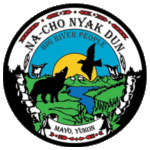Community
The First Nation of Na-Cho Nyak Dun represents the most northerly community of the Northern Tutchone language and culture group. In the Northern Tutchone language, the Stewart River is called Na Cho Nyak, meaning Big River. The First Nation of Na-Cho Nyak Dun resides in the community of Mayo, Yukon, and a town that had its beginnings during the boom years of the silver mines in the area. First Nation of Na-Cho Nyak Dun’s Traditional Territory covers 162,456 square kilometres of land, that being 131,599 km2 in the Yukon and 30,857 km2 in NWT.
Historically, the First Nation of Na-Cho Nyak Dun lived and trapped throughout the area surrounding Mayo. In early times, the ancestors of the First Nation of Na-Cho Nyak Dun lived off the land, using the abundant supply of game animals, fish, birds, and numerous plants for food and medicinal purposes. Their lifestyle required travelling throughout the First Nation’s traditional territory at various times of the year, for hunting, fishing, and gathering food to survive.
The First Nation of Na-Cho Nyak Dun is culturally affiliated with the Northern Tutchone people of the Pelly Selkirk, and the Carmacks Little Salmon First Nations. These three First Nations form the Northern Tutchone Tribal Council, an organization which deals with matters and issues that affect all three First Nations. The First Nation of Na-Cho Nyak Dun represents the most northerly community of the Northern Tutchone language and culture group. Some of the members of the First Nation of Na-Cho Nyak Dun trace their ancestry to the Gwitchin people of Northern Yukon and the Mackenzie people of Eastern Yukon.
The First Nation of Na-cho Nyak Dun is culturally affiliated with the Northern Tutchone people of the Selkirk First Nation and the Little Salmon and Carmacks First Nation. During these times, the Northern Tutchone dictated the terms of exchanges with their foreign trading partners. The oral history of the Na-Cho Nyak Dun also reveals early contact and trade relationships with explorers and traders coming into the area.
The 19th century brought dramatic changes to Yukon First Nations. The First Nation of Na-Cho Nyak Dun readily accepted these new challenges. In 1915, Reverend Julius Kendi arrived at Fraser Falls, where many people of the First Nation of Na-Cho Nyak Dun were drying fish. Reverend Kendi was a Native catechist of the Anglican faith, from the Peel River district. Reverend Kendi asked the First Nation of Na-Cho Nyak Dun to decide on a site where they could establish their Village. The decision was made to locate two miles below the Village of Mayo on the banks of the Stewart River. Albert Tom was the traditional chief at Village on the Stewart River for 55 years. The area is now known as “The Old Village”.
The First Nation has been very active in the Land Claims movement since its beginnings in 1973. Members of the First Nation of Na-Cho Nyak Dun were instrumental in helping to guide the Council of Yukon First Nations and its member First Nations during the critical times ending in the 1984 breakdown of negotiations and rejection of the agreements. Two of the crucial issues were the absence of self-government and the extinguishment of aboriginal rights. These two critical elements, self-government and the retention of indigenous rights on settlement lands, were eventually included in the 1993 agreements.
The First Nation of Na-Cho Nyak Dun today has a membership of 602. As a self-governing First Nation, the First Nation of Na-Cho Nyak Dun can make laws on behalf of their citizens and their lands. Under the land claims agreement, the First Nation now owns 4,739.68 square kilometres of settlement lands and has received in compensation $14,554,654 for which a trust has been established. The First Nation has been actively involved in affairs of the Mayo community, attempting to promote a better, healthier lifestyle for its future generations and a strong economy based on its abundant natural resources.
